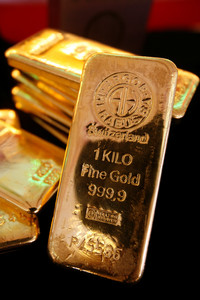SIZING UP THE GOLD MARKET / THE FINANCIAL TIMES ( VERY HIGHLY RECOMMENDED READING )
Note from the editor
Sizing up the gold market
By Jack Farchy in London
How much gold is traded every day? This is a question I am regularly asked by colleagues, readers and editors.
The rather frustrating answer is, we don’t really know. While there are data on gold futures trading in New York, and the volume of bullion that is cleared on the London market, the vast majority of the market is uncleared and over the counter, and there are simply no data on how big it is.
Until now. The London Bullion Market Association has just carried out a study that goes some way to quantifying the size of the over-the-counter market – or at least the London-based part of it, which is a healthy share of the total.
The LBMA asked its members, which include the world’s top gold traders, banks and refiners, to provide information on their gold trading in the London market, called loco London, for the first quarter. It was the first time such a study had been carried out since 1996, when the Bank of England surveyed the top gold traders, and the broadest survey of the London gold market ever undertaken.
The conclusion is that the volume of gold traded in London is ten times what is implied by the clearing statistics: 10.9bn ounces of gold, worth $15,200bn, changed hands in the first quarter of this year, according to the LBMA’s estimate.
That is 125 times the annual output of the world’s gold mines – and twice the quantity of gold that has ever been mined.
What’s more, it is likely to be an underestimate, the LBMA notes in the most recent issue of its in-house magazine, Alchemist, because not all members replied to the survey. Nonetheless, data was provided by all of the “market-making members” – a group which includes Goldman Sachs, HSBC, JP Morgan, Credit Suisse, UBS, Deutsche Bank, Barclays, ScotiaMocatta, Mitsui and Société Générale.
The 10.9bn figure compares to 1.2bn ounces of gold trades that were cleared – in other words, only a tenth of gold traded on the London market is cleared. About 1.2bn ounces were traded in the form of Comex futures in the same period.
Some other titbits of interest:
■ The average size of trades that were cleared was much smaller, at 10,000 ounces, than the overall average trade size, at 28,000 ounces. Presumably this is because banks prefer to clear trades with smaller counterparties, who in turn are likely to be doing smaller trades.
■ The vast majority of the trading – roughly 90 per cent – was in the spot market, rather than forwards, options or swaps.
The reason the LBMA carried out this survey, after 15 years of a data black hole, was to demonstrate to regulators that gold is a “liquid” asset. That classification could allow it to be included in banks’ liquidity buffers under the Basel III regulations – an important distinction for banks such as the ones listed above that have large gold trading operations.
Do the data prove the case for gold? Possibly. Comparable data that include uncleared, OTC markets are hard to come by, but, for example, the $240bn average daily turnover in the London bullion market is higher than the global daily turnover of any currency pair except for the dollar/euro, dollar/yen, dollar/sterling and dollar/Aussie dollar, according to the most recent Bank for International Settlements survey (which refers to April 2010).
The dollar/Swiss franc, that other great safe haven trade, is worth a mere $168bn a day.

0 comments:
Publicar un comentario